It’s been a couple of years now since Natural Paving, as was, morphed into Talasey Group, undergoing some weird form of hard-landscaping mitosis in the process to sire a whole family of sub-ranges and new brand names. I would guess that most of us have more-or-les got the hang of it all now, even though most contractors to whom I speak still talk of Natural Paving or EnnPee, as the jargon has it.
Now that the fog has cleared, it’s easier to see the wood amongst the trees and recognize the strength of having discrete brands, each with a strong presence, but collectively operating under one banner. Yes: some of the brands have more of a physical presence, the oaks amidst the hazels, but overall, it’s looking very much like a healthy and thriving copse amongst the forest of hard-landscaping products.
This year, the Talasey Brochure has become “The Landscape Directory”, which is a reasonable summation of what lies inside. By having brands offering traditional and porcelain paving, clay pavers, placky grass, resin surfacing, trendy decking and a range of accessory products, declaring it to be a simple ‘paving brochure’ would be too narrow a term for the panoply of delights within.
However, a mere 120 pages at 230mm square doesn’t really shout ‘Directory’, not when you compare it with some of the chunky ‘brochures’ put out by rival suppliers this season. If their 180+ pages is a brochure, how can 120 pages be a directory? For me, old and daft enough to remember the door-stopper telephone directories of yesteryear, the term implies weight, mass, volume and comprehensive fullness. This Directory feels a bit short of all that.
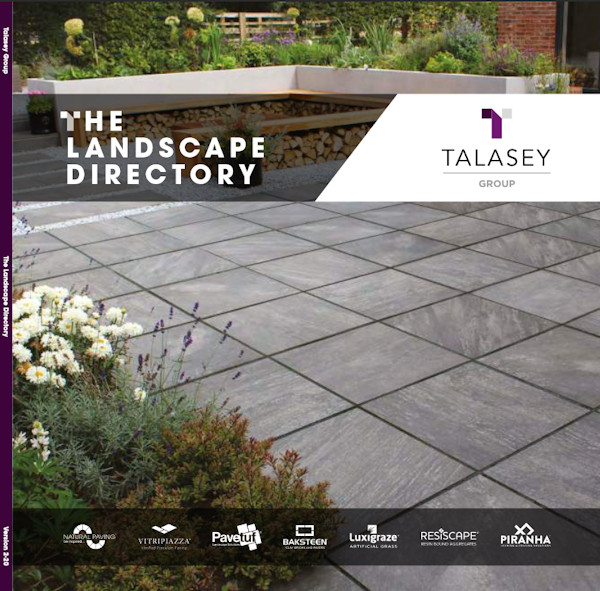
Off we go with the double-page contents before you as soon as the cover is opened, and it’s an effective display, with each individual brand standing its ground by means of strong colour coding and reasonably self-explanatory images. Eight brands now, with the lead position given to Vitripiazza, the porcelain collection, given prominence over all the others, even the original Natural Paving brand which has somewhat shrunk its brief to focus very much on Indian sandstone.
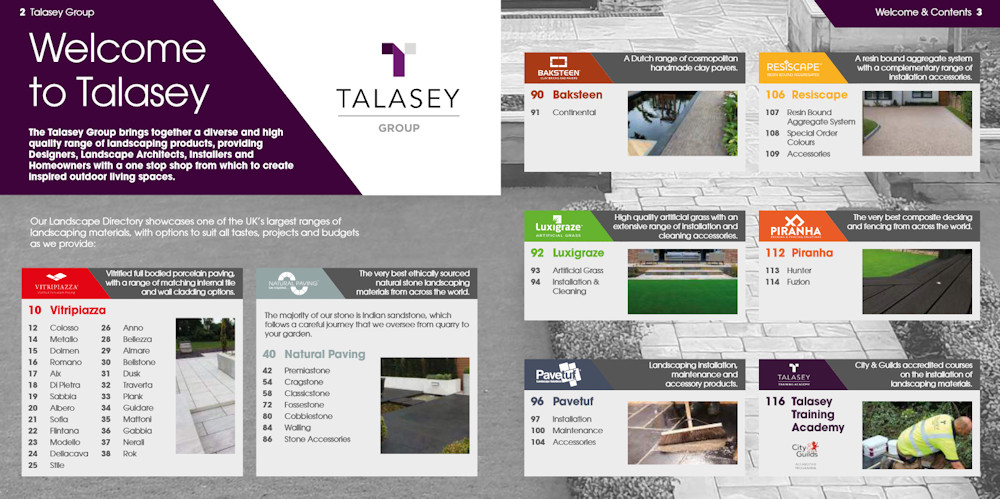
Interesting to see the Talasey Training Academy given a place amongst the brands. The failure of our industry to properly implement a nationally recognised training program has all but forced the likes of Talasey to offer their own educational establishments, to fill the skills gap, and ensure we have a workforce capable of installing the ever-expanding gamut of demanding new materials. While it shouldn’t fall upon the shoulders of Talasey et al to set the training standards for our trade, what alternative do we currently have? There’s no effective leadership from CITB or CECA; there’s dilution and diminution of traditional skills by the soft-landscaping acronym-led crowd; and there’s a shameful reluctance to invest in upskilling by far too many contractors who reckon they already know it all.
In the absence of nationally established standards, a thorough curriculum, and an authoritative testing/examination regime, we have to be grateful that efforts such as the Talasey Training Academy are doing what they can.
Anyway, on into the trees to see what we can find, starting, almost inevitably, with Vitripiazza. There’s a well-considered explanatory introduction (which will inevitably be skipped by those most in need of its advice) which looks at issues such as rectification, porcelain vs ceramic, and the all-important slip resistance. This is followed by a condensed and concise taster menu of the available products. Colosso, the super-sized tile (as big as 3240x1620x20mm) is, understandably, given a double page spread, but just a single image depicting one colour option (the light-grey Athos) while the other colours are restricted to swatches that aren’t even postage stamp sized. Admittedly, there is a secondary, very minor image of the darker Cronus colour, but the photie is small enough to be practically useless.
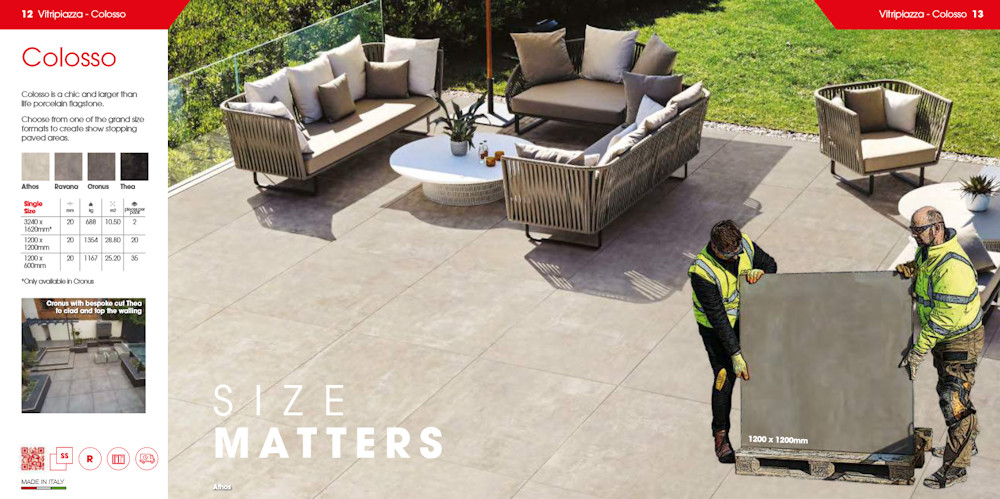
For all the other porcelains, and there are plenty of them, the format is a single useful image covering two-thirds of the page, with the other third devoted to teeny-tiny swatches, size and packaging info and, occasionally, a secondary minor image of pretty limited value.
The sheer number of options with porcelain is becoming something of an issue for me. The fact that it’s perfectly possible to make almost any colour, texture, size, style or format with porcelain doesn’t mean that it necessarily should be made. We are approaching, or may even have reached, the point with porcelain where we are overwhelmed by choice, shown huge, unfathomable ranges with products that differ only in the merest shade or texture. I often feel over-faced, lost amongst the plethora of choice, and yearning for a more assiduously curated selection. We experienced something similar with block paving in the 1990s, then with imported stone in the 2000s. It does eventually settle down – thankfully! – but for now, it seems we are obliged to leaf through page after page after page of bordering-on-indistinguishable tiles.
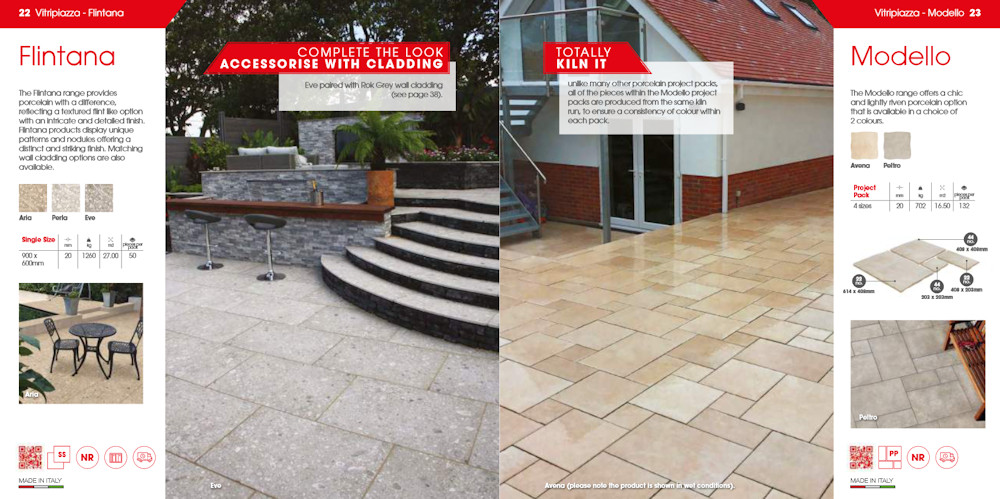
Back to the content and barging through a little bit of undergrowth to emerge in the Natural Paving section of stone products which follows the pattern established by porcelain: a ⅔ hero image and ⅓ blurb/tech-info/secondary-image. It's mostly sandstone, and much of it honed, which is understandable from a profit margin perspective but disappointing from a suitability point-of-view. As tempting and lovely as it may be, there are too many horror stories involving honed sandstone just at the moment. It requires meticulous and exacting installation to get the best from it and all too often, potentially gorgeous stone is ruined by inappropriate, cack-handed installation.
All I can spot that is new are flamed options for the wannabe Yorkstone York Mix and the pale Rydal, both sandstones. Everything else seems as it was – unlike the burgeoning porcelain scene, the imported stone offer has very much settled on a palette of familiar favourites. Talasey/Natural Paving’s offer is a fair representation of what sells with nothing really daring or exciting, but that’s completely understandable for a market that is long past saturation point and now needs only serve up what the stone-buying public fully expect: the safe sandstones, the under-utilised Kota limestones, a taste of slates and a token granite, all in the familiar Projects Packs or Sett formats (which they are *still* referring to as bloody cobbles which they most definitely are NOT!).
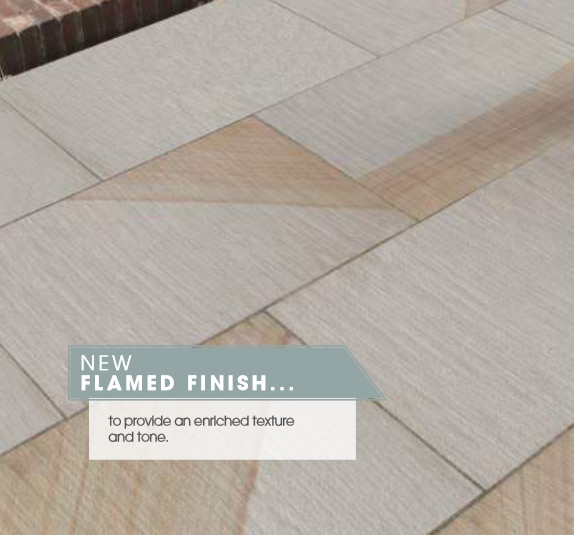
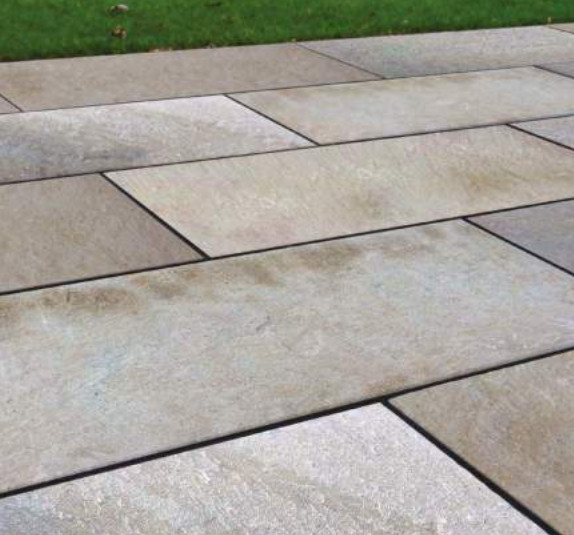
By the time we emerge from the covert of stone paving, we’re on page 90 and precious little tree-cover remains to extol the delights of the so-far unrevealed sister brands. Just a basic double page spread for Baksteen clay pavers, which seems grossly unfair for what is a delightful and increasingly popular product. How can two pages do full justice for seven different colours? And it hurts even more when the shrubbery clears to reveal twice that amount of coverage for placky grass! Luxigraze may well be a ‘good little earner’ and increasingly an essential part of many a patio makeover, but is it really deserving of twice the footprint of clay pavers?
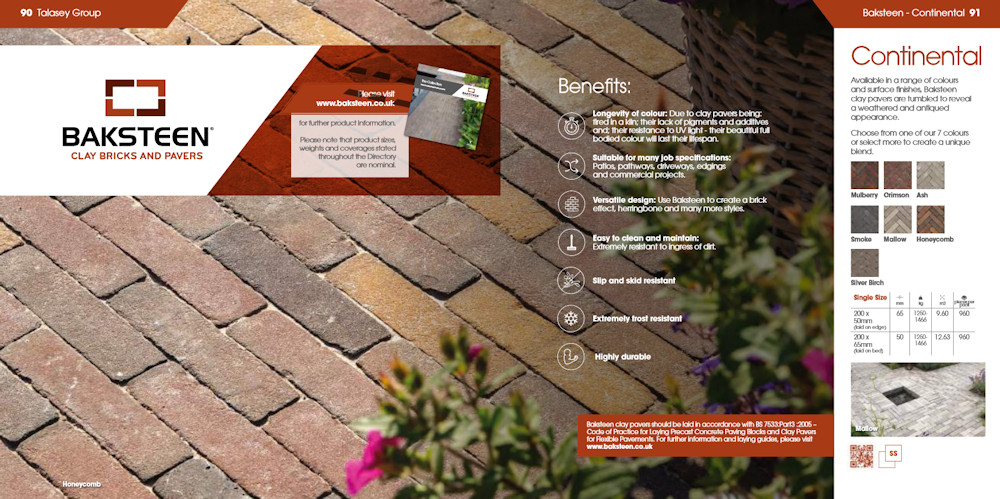
And the Pavetuf range of accessories is afforded no less than 10 pages! Admittedly, the range grows on what sometimes feels like a weekly basis, now including a bewildering array of jointing media, sealants, cleaners and more. As with a brochure reviewed just a couple of months back, pedestals are also being touted as a possible installation option, despite them being trickier than threading a tow rope through an embroidery needle. Porcelain cleaner? Really? Isn’t the big selling point for porcelain the alleged fact that it doesn’t get dirty?

The expansion of the Pavetuf range is one of the best ideas Talasey have ever had. The provision of appropriate accessories and ancillaries, of proven quality, and presumably tested for compatibility with the main paving products has been a growing hole in the offer of far too many suppliers for far too long. Oh! They dabble with a bucket of jointing jollop here and a pack or slurry primer there, but I reckon Pavetuf is the most comprehensive offer from any major supplier…and it continues to grow!
We can almost see daylight now, but before we fully emerge from cover, there is Resiscape, the resin bound brand from Talasey. I can understand why a business such as Talasey would feel they need to offer a resin surfacing product, but I can equally understand why many other suppliers/distributors/manufacturers keep well away from it. Resin surfacing is having something of a moment and with heightened interest from consumers comes heightened involvement of chancers and ne’er-do-wells who move on from ballsing-up blacktop to ballsing-up resin surfacing and then, with the inevitability of night following day, blame the products when the balls are well-and-truly up in the air. It has the dubious and wholly unwanted honour of taking over from Pattern Imprinted Concrete as the single most complained about surfacing/paving option via this website.
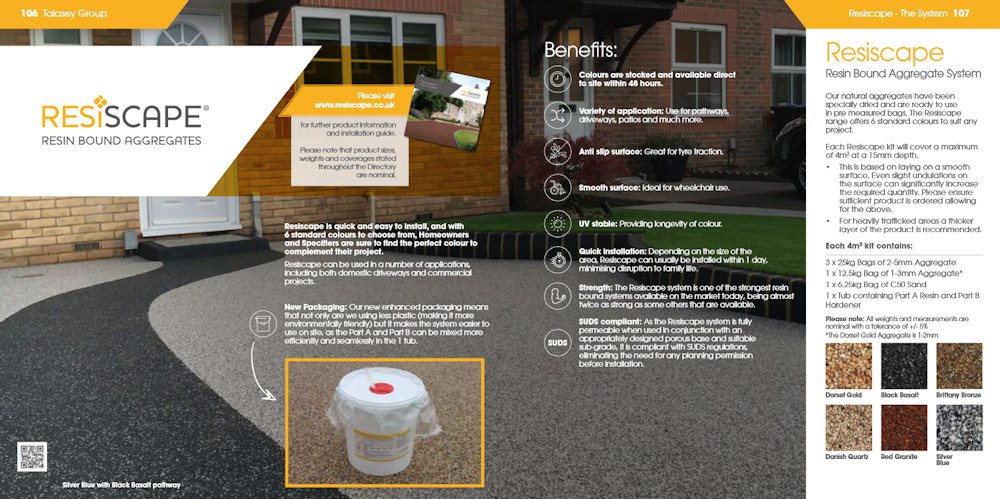
The proper installation of resin surfacing is a demanding and exacting skill. Bonus points must go to Talasey and their TTA in trying to convey this message to their students, but I have to say I’m much more relaxed when I know resin surfacing is being installed by a full-time, properly trained and experienced installer.
As for Resiscape, can a sub-brand of a larger landscape supply business ever really offer the breadth of choice that comes from a specialist supplier, or the depth of knowledge that resides with those full-time accredited installers? There is, and will always be, a market for smaller scale installations, a few tens of metres here or a small driveway there, but I suspect the big, commercial and prestigious jobs will keep going to the specialists in this very demanding corner of our industry.
The composite decking brand, Piranha, is relatively new but swimming amongst sharks in a fiercely competitive market. The resurgence of interest in decking stems from the use of composites and urethane mouldings that override many of the issues the cheap’n’cheerful lumber beloved of Alan Pitchfork and his gardening chums in the 1990s. Even a cynic such as I can see the appeal of a rot-proof, naturalistic, low-maintenance and low-cost (ish) option such as this, but, again, is it a product for a generalist supplier such as Talasey, or should it be left to the specialists?

And there we are – open fields ahead and just the briefest glimpse of the Talasey Training Academy, of which there may be more said at some later date. The gist of it was broached earlier in this saunter through the world of Talasey, but I would urge anyone interested in upgrading their existing skills or acquiring new ones, to explore further. Full disclosure: I wrote one of the courses but try not to let that put you off too much!
TTA can’t, obviously, provide every aspect of training, nor can it ever deliver the depth of experience that cam with the apprenticeships some of us endured in the 1960s and 70s, but it is a step in the right direction.

So: what of the brochure….sorry, the Directory as a whole? Well, I’m more convinced than ever that it is a Directory and not a brochure. It offers just a brief introduction to the wider range, exactly as Yellow Pages once offered a brief introduction to local traders, nothing more than a phone number and an address, but it was then incumbent on the reader to seek out further detail: the suitability, the costs, the availability.
The imagery throughout is good, although the value of the small secondary photographs on some pages is debatable. I suppose they are, on balance, just about preferable to empty white space, but there’s not a lot in it! I would have liked to see more double-page hero shots – these are what sells paving to a customer, but that has to be balanced against the limitations of space. The swatches are generally pathetic: far too small to provide anything more than the merest suggestion of colour and no clue at all regarding texture or character.
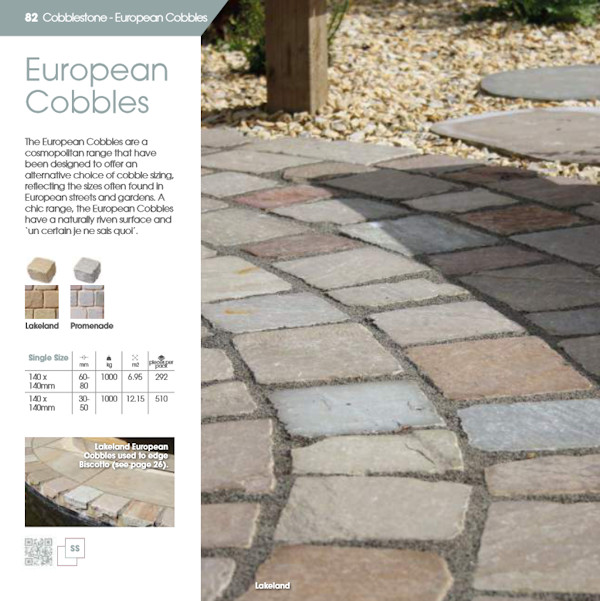
The explanatory text is satisfactory – ideal in terms of quantity but a little variable when it comes to quality. However, the longer pieces, explaining, say, the benefits of porcelain or the installation of placky grass, are very good and bear the hallmarks of an experienced hand, in terms of handling both the products and the words.
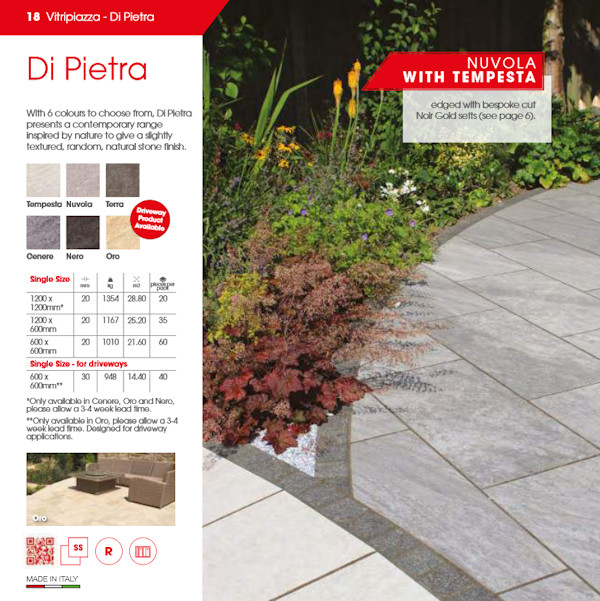
And the general look, feel and styling is comfortable, appealing and easy-going. It straddles the middle ground between coffee-book formality and throwaway Sunday paper insert. Not too big, which is always a good thing, but only just managing to be not too small. An additional 20 pages or so would not have been too much.
In an age when more and more of the selling part of the job is done online, on tablets and on smartphones, the role of a brochure or directory must adapt. Maybe a directory *is* the way forward – offer them a taste, then provide the fuller menu via a website or social media set-up. I’m sure that will appeal to some, but for others, there’s nothing quite like a well-constructed brochure or directory to give you a measure of the company behind it.
The Talasey Landscape Directory for 2020 is the amuse-bouche. It teases and pleases and it draws you in to demand more. And that’s why it deserves the success that is surely awaiting in the months ahead.
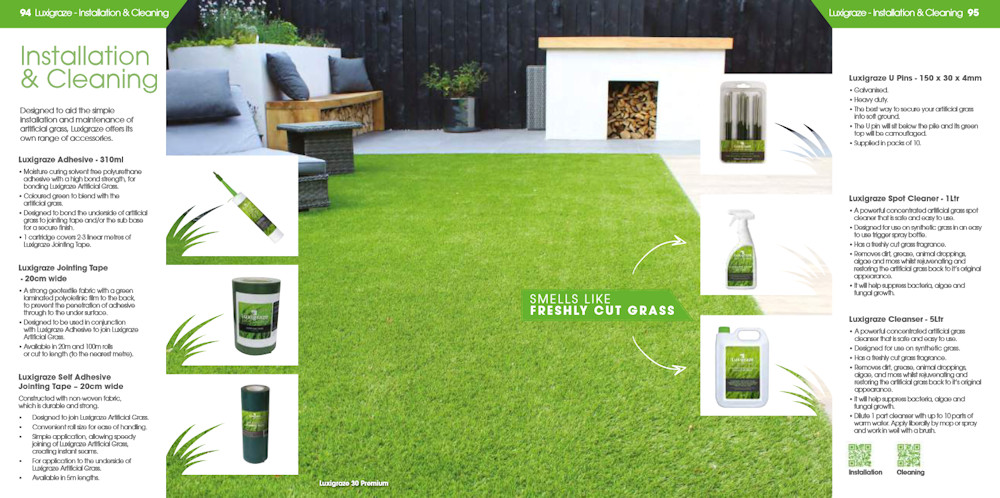

Further Information:

Talasey Helpline: 0330 333 8030




